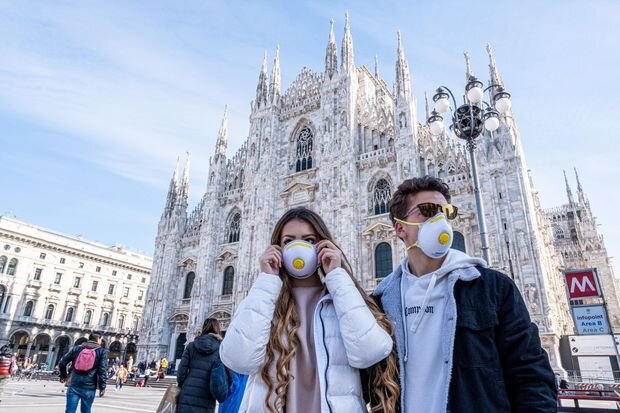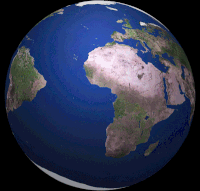Italian newspapers are known for their hyper-partisanship. The country has dozens of dailies and they have political allegiances that are tied to parties of either the left, right or center. It’s not unusual at all, of course, for newspapers in Europe to approach news and commentary from this partisan lens.
Hunger for information during the coronavirus pandemic — of which Italy has seen the world’s highest death toll when it surpassed 10,000 this past weekend — has led to some exceptional reporting. In the process, many Italian journalists have fallen ill from the virus while covering hard-hit areas like the northern Lombardy region.
While Italy’s newspapers have always covered news through a partisan lens, COVID-19 has led to lots of strong journalism as well as coverage of plenty of religious angles.
Newsrooms across Italy have closed — with editors working from home — while reporters in the field have reported on the national lockdown’s disruption of daily life and how the contagion has ravaged communities and families. I have been closely monitoring and reading several of Italy’s dailies even before the pandemic spread to the United States. How the deadly virus overwhelmed hospitals and led to the casualties of so many of its citizens (Italy has one of the world’s lowest birthrates and oldest populations) in such a short period of time is something truly grim and scary.
I examined several of Italy’s largest-circulation dailies — La Repubblica, Il Messaggero, La Stampa and Il Giornale — that span the political spectrum. La Repubblica (which leans left), Il Messaggero and La Stampa (which are both centrist) and Il Giornale (a right-wing outlet) all have one thing in common — all of them have included religion in their coverage. In fact, none of them have shied away from the subject in a country that is overwhelmingly Roman Catholic.
While some Italians have been resentful of the church’s power and authority in the past, the pandemic has led to a religious revival of sorts. It has also been covered largely fairly and accurately by the press.
Pope Francis has prayed and delivered an “Urbi et Orbi” blessing – normally given only at Christmas and Easter – from an empty St Peter’s Square amid the #coronavirus pandemic.
Get the latest on #COVID19 here 👉https://t.co/CjQVq5YqCW pic.twitter.com/Fu2f9KNsAC
— Sky News (@SkyNews) March 28, 2020
RAI, Italian state television broadcaster (something akin to the BBC), has broadcast Pope Francis’ Mass live every morning at 7 a.m., while the Vatican, a separate city-state located within the Italian capitol Rome, has also had to deal with COVID-19 cases. In one form or another, the pope is either on TV or in the newspapers every day as a result of the pandemic.
At the same time, the world’s news media has been reporting on Italy over the past few weeks as the death toll increases and hospitals become overwhelmed with patients.
It was back in early February that the Italian press began reporting about early coronavirus cases in Italy tied to Lunar New Year celebrations. While many are unaware of this, there is a large and thriving Chinese community in northern Italy (some 300,000 live in the country of 60 million) as well as lots of Chinese tourists (nearly 800,000 annually) to some of the country’s biggest attractions each year. This is something U.S. heath officials only recently confirmed when trying to retrace how the virus spread from China to Europe and now the United States.
Il Messaggero was one of the first newspapers that made the connection between Chinese travelers — in this case those who visited family in China only to return to Italy — and the need to quarantine them as far back as Feb. 1.
This is the key section that I translated from the original Italian:
There are no norms to respect, but a lot of common sense. The warning to mayors: In some cases, municipalities can recommend to Chinese families, who have recently returned to Italy, a preventive home isolation that will last two weeks to be observed even if there are no symptoms. Do not crowd the hospital for a simple flu. It is better to contact a general practitioner.”
Italy’s now-disfigured society is a crystal ball into our own immediate futures in the United States. But the connection between religion and the virus isn’t limited to the Lunar New Year. Mardi Gras, the start of the Lenten season, is now something that could have contributed to the spread in New Orleans. This story, too, was covered in Italy’s dailies. At the same time, Italians who celebrate carnival (primarily in Venice), had already limited their outdoor activities.
That was another warning sign — reported in the Italian press — that went largely ignored elsewhere on the planet.
Il Giornale, which is owned by media magnate and former right-wing Prime Minister Silvio Berlusconi, ran a piece recently casting doubt on the number of infected and dead in China, where the virus originated in the province of Wuhan. It was not an unusual story for a newspapers that has traditionally been anti-Marxist and very pro-business. It should be noted that the story, which had no religion angle, ran with a prominent photo of men in white HAZMAT suits decontaminating the inside of a — where else? — church.
The biggest area of coverage has been in how people have been forced to worship from home. With churches closed, priests across Italy have gotten creative about how to conduct Mass. Other priests have risked their lives tending to parishioners. One church, in a town near the southern city of Naples, saw the carabinieri, the country’s para-military police, break up a clandestine service.
Here’s a translation of a short story that appeared in La Stampa:
The Carabinieri raided in a church in Sant’Anastasia, where the parish priest was celebrating a Mass behind closed doors reserved for “a few close friends” despite the prohibitions imposed for the containment of the coronavirus infection.
The officers, under the command of Captain Marco Califano, entered the Franciscan church of Sant’Antonio, where there were nine people brought in by a secondary entrance, while a friar regularly celebrated the mass of 8 a.m.
The religious service was interrupted and those present were identified and reported to prosecutors.
Italy’s lockdown rules calls for possible imprisonment and fines for violators. While religious freedom is not a major political cause in Italy, this case highlights the fragile balance between faith and forced quarantines. It is something that Christians who live in democratic countries around the world are now also grappling with as infection spreads.
The most heartbreaking stories have come from families who have seen loved ones die, only unable to have a proper funeral for them since all public gatherings of any kind are banned.
La Repubblica, co-founded by Eugenio Scalfari, has had some of the strongest coverage. It should be noted that Scalfari is the same journalist who has had no qualms in the past of reporting on his conversations with Pope Francis, often putting out information that has put the pontiff and church teachings in a bad light.
La Repubblica also highlighted the meeting that took place Monday between the country’s Prime Minister Giuseppe Conte and the pontiff. The article highlighted Conte’s Catholic connections. While a student in Rome, Conte attended Villa Nazareth, a Catholic college that includes noted alums such as Italian president Sergio Mattarella and former prime minister Romano Prodi.
The Catholic connections aside, all the major newspapers’ city editions — and Italy’s many smaller dailies — have been running page after page of obituaries and death notices of people who have died from the contagion. The average age of those who have died is 80.
Graphs are useful but to really get what that rising curve is, have a look at the obituaries page of this Bergamo daily newspaper, comparing one from February with one from now pic.twitter.com/78mgZseyVt
— Ben Phillips (@benphillips76) March 14, 2020
A March 23 story that appeared in the newspaper began this way:
At the last greeting in streaming we don’t speak, we only write. There is no hug, there is no noise, only a flow of “R.I.P,” always written in capital letters and many “heartfelt condolences to the family.” Both were signed with crying emoticons.
They are the funeral online at the time of the coronavirus: prohibited by a national decree, funerals have been moved to the web in towns near Brescia, Mantova, Naples and Bologna.
Day after day, while the emergency for the pandemic continues and the death toll for COVID-19 is growing, the funeral homes are reinventing themselves, broadcasting online videos for family members and friends at home who cannot bring the latest live greeting. As a result, the funerals now enter the home. Live funerals, in real time on Facebook on parish pages, or on websites of specialized obituaries.
Could this be what happens in the United States?
Journalists can pay attention to the Italian media if they are seeking a glimpse into our grim futures.











